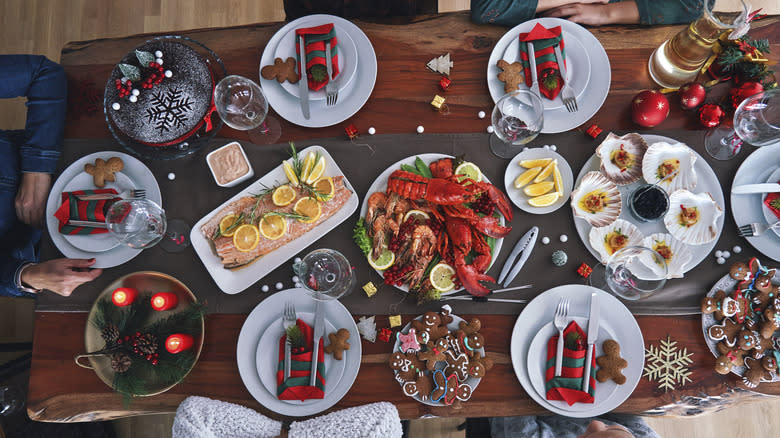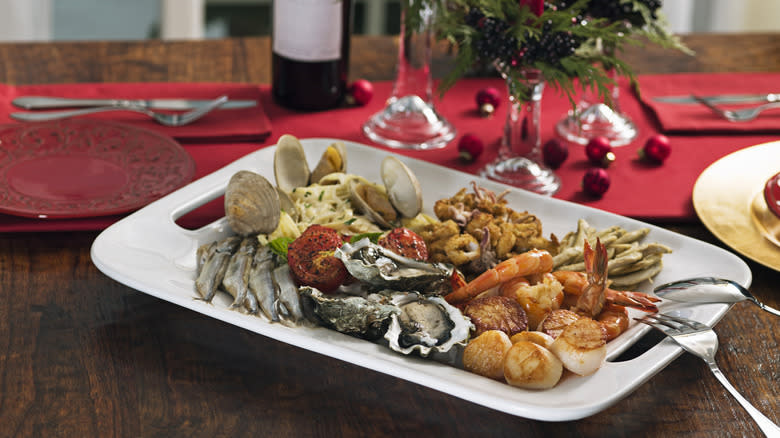The Historic Origin Of The Italian-American Feast Of The Seven Fishes

Holiday traditions are in many ways an enigma. Leaving raw oats out for Santa's reindeer might seem like a weird thing to do to an unwitting onlooker. And what's the deal with fruitcake? In many Italian-American households, no Christmas Eve is complete without the Feast of the Seven Fishes. But in other Italian-American households, they're serving lamb, and aren't eating seafood at all. In point of actual act, the Roman Catholic Calendar doesn't recognize the Feast at all.
The Feast of the Seven Fishes is a huge dinner consisting of seven different fish and seafood dishes. It's a popular nostalgia-fueled tradition held on Christmas Eve. The holidays bring out the sentimental side in everybody, and when Christmastime rolled around in early-1900s America, many Italian foodies were craving the beloved dishes from their native country. Per the lore, the Feast might have started among 20th-century Italian-American immigrants, who combined classic Italian dishes with seafood, which was a locally available ingredient.
In many ways, the Feast of the Seven Fishes is a fusion of new meets old. In fact, modern foodies call it the Festa dei Sette Pesci, but the first wave of Italian-American immigrants called it La Cena Della Vigilia, Il Cenone, La Vigilia di Natale or La Vigilia. Yet in Italy, the Feast of the Seven Fishes isn't a thing. The event is a uniquely Italian-American tradition. So, where did it come from?
Read more: 44 Types Of Pasta And When You Should Be Using Them
A Tradition As Beloved As It Is Ambiguous

The Feast is an event steeped in tradition, but nobody seems to know exactly where it came from or what the "seven fishes" part is all about. It might have been inspired by the biblical importance of the number seven: the seven sacraments of the Catholic church, the seven hills of Rome, the seven deadly sins, the seven virtues, or the "seventh day of rest." The earliest written mention of the Feast comes from a New York Times article in 1987. So, it didn't come from Old World Italy, but it might have originated with foodies from Southern Italy, which spanned the coast and where seafood was a huge part of the daily diet.
Aside from regionality, religion might have further inspired the seafood-centric aspect of the feast. Many Italian Americans practice Roman Catholicism, and traditional Roman Catholics don't eat meat on holidays. Fasting is customary before receiving Communion, especially on feast days, and Christmas Eve is the lead-up to the Feast of the Nativity on Christmas Day. Before the 1960s, December 24 was recognized in the Roman Catholic calendar as The Vigil of the Nativity of the Lord -- not a feast day, but a day of abstinence (not eating meat) before the Christmas feast. This might have been what prompted the Feast of the Seven Fishes, as eating seafood doesn't count as breaking abstinence, and celebrating foodies could still chow down on the 24th.
Modern Tables Showcasing Classic Dishes

On the Feast of the Seven Fishes, baccalà (salted cod) and calamari are near-universal staples. But, other than that, dishes vary heavily from family to family and are often passed down generationally. The popularity of baccalà might have come from the fact that it's an affordable fish in Southern Italy and was a popular ingredient in Old World peasant cooking. In fact, when Northern and Southern Italy unified in 1861, the southern regions (lacking federal funding) devolved into such extreme poverty and organized crime that roughly four million Italians were forced to immigrate to America between 1880 and 1924. Many of the first wave of Italian-American immigrants from Southern Italy would have already been super familiar with the fish.
But, baccalà is only one dish. The Feast often lasts for multiple hours, and there's a smorgasbord of different seafood dishes to keep foodies more than occupied. Popular holiday fare includes scallops, red clam sauce, shrimp puttanesca, and savory zeppole stuffed with anchovies. Some families serve classic American shrimp cocktails. Others serve baked clams, fried smelts, scungilli, mussels, and lobster, either in cioppino-style seafood stew or Lobster Fra Diavolo.
Read the original article on Tasting Table.

